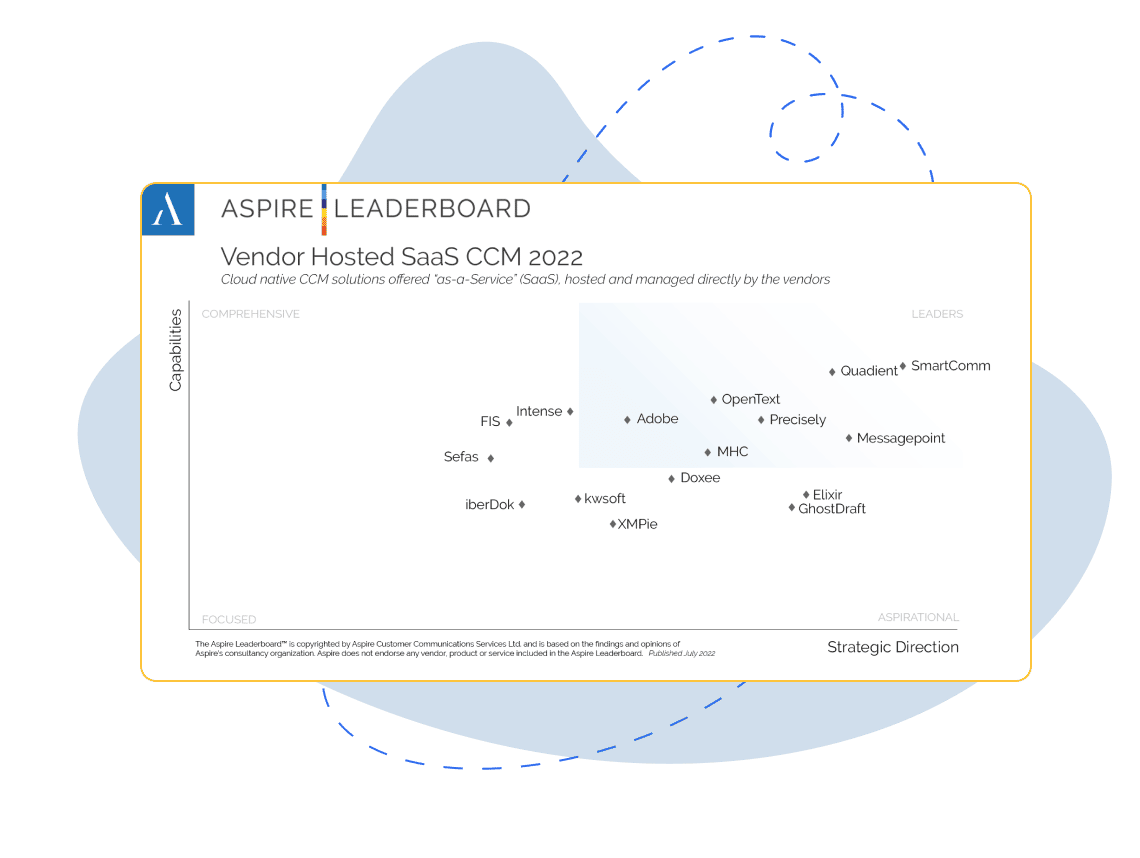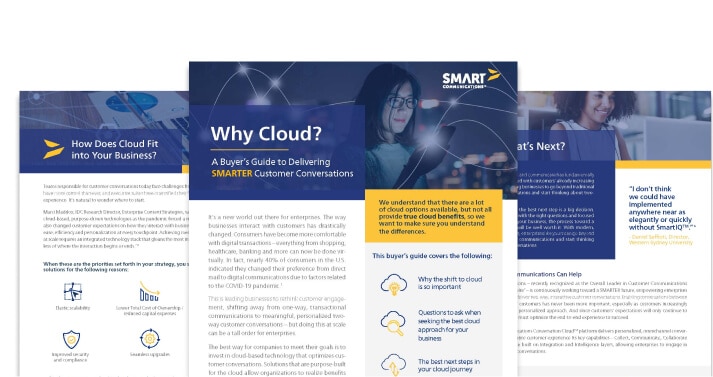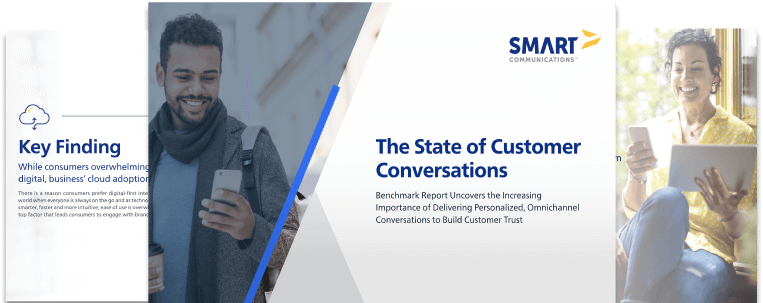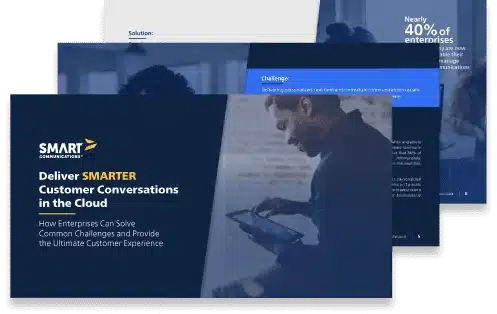There may never be a ‘perfect’ time to purchase new software. However, as consumers increasingly prefer tailored, digital-first experiences, companies — especially those across highly regulated industries — should start digitizing the end-to-end customer experience. Keep in mind that streaming platforms, like Netflix, and delivery services like Amazon, have set the expectation bar high and customers’ demand for ease of use only continues to grow. This is simply a feat that manual, legacy systems can’t account for. Nor are they sophisticated enough to handle the level of personalization that’s needed to build brand loyalty, foster better customer relationships and allow employees across workforces to work comfortably from anywhere they are.
Building a Business Case for Change:
How to Secure Stakeholder Buy-In When
Purchasing Enterprise Customer
Communications Management (CCM) Software
In today’s fast-paced world, many companies are looking for innovative ways to keep up. With technological advancements remaining a top priority for business leaders globally, software investments are an obvious choice when considering wider digital transformation.
When investing in new CCM software and systems, leaders and stakeholders will need a plan in place that accounts for everything from identifying the right solution to onboarding or migrating legacy systems. Considering the wider changes or disruptions that can come from such an investment, it’s important to include input from senior leadership all the way down to the end business users. With the right approach (and vendor partner), enterprises can make the process as seamless as possible.
It’s also key to remember that customer expectations are shifting alongside the market changes. Customer experience is a big part of how companies retain customers, build brand loyalty and trust, and attract new business. In fact, research showed that 81% of consumers consider communications to be part of their overall experience with a brand. With so much at stake, enterprises need to focus and put more emphasis on how they deliver communications to their customers.
In order to shift away from one-way, transactional communications to two-way, interactive conversations, enterprises need cloud CCM software to help them meet customer needs and continue to evolve and scale as those needs change over time.
When looking to determine the potential ROI and making a final decision, we highly recommend creating a business case. In Building a Business Case for Change, we include best practices, as well as a rough outline of steps to follow and who to involve when attempting to purchase new enterprise customer communications management (CCM) software, including:
Overcoming barriers to change or common objections from stakeholders
Identifying and selecting CCM software candidates
How to draft a business case for new software
Questions to ask during the selection process
The ROI of investing in customer communications management software
Keep reading if you’re ready to build the business case for a modern CCM solution.

Discover why enterprises have partnered with Smart Communications for CCM software and how delivering two-way, interactive customer conversations can benefit businesses across all industries. Check out ‘The Ultimate Guide to CCM Software and Strategic Solutions’
What is a Business Case and Why Do Enterprises Need One When Purchasing or Upgrading CCM Software?
A business case is a tool used to justify a business decision and determine if the new project or technology is worth pursuing. A business case documents how the decision might alter cash flow, including the ROI it could elicit, and what costs will be incurred over a period of time. In theory, a successful business case will help leadership and other project sponsors overcome inefficiencies during the selection and decision-making processes.
Select and implement a new product faster and with less friction. There will likely be a few key contenders throughout the vendor selection process. The more options there are, the tougher it can be to make a decision. A business case helps create a focused plan that will inevitably allow all parties involved to expedite the implementation of a new product.
Differentiate what’s a ‘must have’ versus a ‘nice-to-have.’ As mentioned above, more options mean it may take longer to make a decision. That’s why a business case should include what is an absolute necessity when looking at new systems and what may just be a ‘nice-to-have’ feature.
Executives/decision makers determine whether to move forward. Business leaders and decision makers are constantly inundated with choices to make, all while looking out for the best interests of the company and its people. They need the right information in front of them when deciding on the best way forward. It can also highlight the cost and risks associated with remaining in a status quo holding pattern if software upgrades or digital transformation isn’t prioritized.
Address challenges that may be solved by the purchase of a new system. Creating a cohesive document that includes everything a business leader might need to know can help expedite the decision-making process and ensure that everyone involved is abreast of potential pitfalls, like budget restrictions or compliance concerns.
Highlight the benefits of adopting a new solution. While it may seem like a lot of work to prepare the business case, it also gives stakeholders a chance to highlight the benefits of purchasing new software. This can include the potential return on investment, company innovation projects that will be made possible with a new system and any other number of benefits for individuals and the wider organization alike.
Improved customer experience and operational efficiency. Delivering a better customer experience should be a top goal for all future-ready organizations. Having flexibility, an innovative mindset and increased productivity will require software that makes it easier to connect with customers in a way they understand and feel comfortable. A business case can help stakeholders identify current customer issues in a more proactive manner as well as allow them to focus on how CCM software will solve these challenges.
Ultimately, when a business case is done right, it can lead to a request for proposal (RFP) or even a purchase decision. Purchasing new IT systems or making large infrastructure changes may be tricky to navigate as there will be multiple teams and individuals involved in the process, from selection to purchase, and everything in between. It’s critical to understand why changes are being recommended, who in the business will benefit from the changes and how the company will receive a return on investment.
This is where a business case can help as it will enable stakeholders to clearly articulate and evangelize the changes proposed in a way that plans for risks but highlights the rewards in a realistic light. That’s why we highly recommend setting up an internal team that will lead the charge in developing a business case for change. This will help when delegating responsibilities through the initial phases all the way up to implementing new software.
Also important to note is that there are risks to not developing and presenting a business case. For instance, it can lead to misaligned goals for an investment or even limited buy-in from stakeholders/decision-makers.
Common Barriers to Purchasing Cloud-based CCM Software
When making the case for cloud CCM software, it’s important to identify both internal and external barriers. Anything from market conditions, inflation or large workforce shifts can deter decision makers from taking on an investment. While it may look like a beneficial investment down the road, business leaders often have a wider view of the company’s near- and long-term goals. Taking this into account, a business case should address some of these common barriers and how the risks can be mitigated.
Some common barriers to consider are:
With the IT infrastructure shifting to focus more on future-proofing business through technological innovation, relying on legacy CCM systems may be comfortable for now. However, businesses that stay in their comfort zones will undoubtedly stay there while tech-savvy enterprises will equip their workforces for the future.
Business leaders are consistently up against the clock when making decisions that help the company remain agile and strategic. Adding a new software investment onto the busy stack of other business-critical decisions to be made can seem daunting. Work with a vendor that offers a dedicated team to answer questions throughout the selection process and has a reputation in the market for providing excellent customer support. This will cut down on the investment required when implementing software down the road.
As mentioned above regarding IT resources, business leaders may be concerned about the bandwidth required to implement new CCM software. That’s why it’s important to work with vendors that offer pure-cloud software with faster implementation times as well as support through onboarding and beyond.
As far as mitigating risks and overcoming the above barriers, this will require insights from an informed team of individuals who understand the ins and outs of the enterprise and industry. This can include the project stakeholders, IT leaders, employees who will work with the software and customers on a day-to-day basis and of course, those who work closely with decision makers. Without a business case, it can be difficult to identify who these people are in the business. It also makes it harder to track and account for the challenges as well as any potential solutions.
For instance, while one stakeholder may be a ‘yes’, others might shy away from the investment if they lack the necessary information or data to see a potential for ROI. Without receiving buy-in from all stakeholders, the investment isn’t likely to be approved.
Overcoming Barriers to Change
While a business case won’t always guarantee an RFP or software purchase, it can help with overcoming common barriers to change. This can help move decision makers closer to the goal post when proposing an investment for new CCM software.
One of the most obvious ways to make a business case is to demonstrate ROI. We’ve witnessed how customers across several industries have recognized the benefits of Smart Communications solutions and the unique ways our solutions and services have helped overcome the common barriers listed above. When it comes to big challenges, like implementation worries or loss aversion, here’s what a few of our customers said:
Insurance Company in NZ Prepares for Future Growth by Implementing Best-in-Class Customer Communications Management Solution
Aioi Nissay Dowa Insurance NZ (Aioi NZ) was functioning with their 20-year-old legacy customer communications system. While it wasn’t failing them, they did realize they would not have scalability, nor could they meet the growth aspirations that they had. The organization needed the help of best-in-class technology in order to future-proof the business.
“Going best-in-class has allowed us the foundational platform to do whatever we want whenever we want. Now we can really dream and take advantage of opportunities for growth quickly. We believe we can do it quicker and more reflexively than anyone else in the market because of our setup.”
– Chief Executive Officer, Aioi Nissay Dowa Insurance NZ
Check out the Aioi Nissay Dowa Customer Case Study
Global Financial Solutions Partner Streamlines User Experience with Digital-first Document Management
Banks and other financial institutions require a robust application process that's often difficult to facilitate when using manual systems and paper-based communications. A good example of this is DLL, a global financial solutions partner and one of our customers. Recognizing that paper correspondence and in-office negotiations no longer work for consumers, DLL set out to offer its customers the flexibility to conduct business digitally. In order to enable this level of sophistication, the team realized they needed to implement a cloud-based digital process in order to optimize their customer conversations.
Moved 95% of their contracts to a digital format, resulting in a 30% reduction in templates
Improved the ability for customers to self-serve
Enabled two-way conversations with its customers
“Our plan is to move all our applications to full cloud in order for our teams to add value to the business, instead of constantly having to work on costly and time-consuming Life Cycle Management projects that do not add value to our business and slow down our time to market.”
– Platform Product Owner, DLL
Check out the DLL Customer Case Study
Mutual Insurance Company Improves Internal Operations by Implementing SmartCOMM
While the initial investment and implementation time for new CCM software can be daunting, legacy platforms do not allow enterprises to prepare for a future in which sophisticated AI is leading the charge. For one of our property insurance clients, NLC Insurance Companies, the decision to purchase SmartCOMM was made easier when recognizing the consistent loss of time and resources resulting in the use of outdated technology.
Modernizing and streamlining document print operations allowed NLC to eliminate in-house printing responsibilities and drastically shorten expected completion times for new projects. Ultimately, this resulted in less time spent on manual tasks (like document printing, for instance) and money lost.
Whether it’s a company in the insurance, financial services, healthcare industry or otherwise, overcoming barriers to change is possible. Identifying key business challenges that a new CCM software can solve is a great starting point. However, it’s also important to remember that potential business outcomes are only one part of what to look for when identifying a software partner. Read on for additional factors to look for when demonstrating value in business cases.
Check out the NLC Customer Case Study

Learn more about why enterprises are migrating from legacy technology to pure-cloud CCM software plus how enterprises can prepare to make these changes.
4 Ways to Identify and Short-List CCM Vendors
When exploring options for CCM software, it’s important to keep several priorities in mind. Everything from integrations to security standards must be top of mind. With that said, below is a checklist of must-have features and capabilities for a modern CCM platform.
For starters, the right vendor will be able to help a company meet its customers where they are, everywhere they are. That requires ongoing innovation and reinvestment in the product, as well as a partner that has a future-forward plan. A partner that is prepared to think ahead and stay abreast of market shifts or changing customer demands will undoubtedly understand why an enterprise wants a CCM software system that can do the same.
While many companies began their journey into optimizing and digitizing communications, there are still enterprises falling short with their use of legacy technology. Older systems can be costlier to maintain and often lack the modern functionality to meet customer needs. Therefore, it’s critical to find a vendor that listens to customer feedback and re-invests in the product to help companies provide tailored interactions across all customer touchpoints.
Smart Communications recognized as an industry leader for Vendor Hosted SaaS CCM 2022 due to recent product enhancements and strategic vision.

Throughout the life of a business partnership, enhancements will need to be made and additional solutions may need to be implemented. Instead of investing in a vendor that installs and moves on, enterprises will need a CCM vendor that sticks around. The right vendor will offer professional services to meet the unique needs of each business. This may include things like installation and content development or integrations with other core systems. There might even be services offered that help onboard new users after the CCM software is implemented. A responsible vendor should assist with legacy migration which can help minimize common barriers and allow in-house IT teams to focus on other initiatives.
It’s important to partner with a CCM vendor that understands the fluid nature of software. The right vendor will have an excellent customer support team that is dedicated to helping enterprises succeed. In addition to 24/7, live customer support, the right CCM partner will provide educational resources and relevant training materials, including a knowledge base or learning academies that can be accessed at any time.
With a great customer support team, companies can ensure that small bug fixes or security patches are completed in a timely manner. This eliminates the risk of customer breaches, downtime and other factors that could lead to upset customers or a damaged reputation.
Not only should the CCM vendor of choice be one that understands the software itself, the right partner will also understand the respective industries of its customers. For instance, highly regulated industries like insurance, healthcare and finance services are all required to meet specific criteria when providing communications across various channels, so the CCM provider must be certified compliant. There may be certifications related to information security and compliance, two very important factors for industries that deal with personal, financial and medical data.
An industry proven CCM vendor will have a deep understanding of the industry landscape, partnerships with industry-specific technologies and should have a list of recently implemented customers to call as references. Cloud-based CCM software is often sophisticated and will require subject matter experts who work with the solution from an industry-specific perspective.
Ultimately, a company must choose a CCM vendor that is a leader in their industry. We believe that leadership comes from a commitment to taking a cloud-first approach that will allow companies across any industry to shift from one-way transactional communications to two-way interactive conversations.
Questions to Ask Internal Stakeholders and End-users
This part is crucial as it will allow those building the business case to properly identify the main business problems/challenges a solution will solve for. When considering questions to ask, consider who the users will be. They could be individuals in customer service or sales roles. Or, they may be IT support staff, administrators, or members of corporate teams who are performing audits or working to optimize business processes.
We also recommend thinking cross-functionally to include members of innovation teams and strategic business leaders (think: customer marketing) who might require customer feedback or data to make critical business decisions. For example, if cash flow is down because of customer retention issues, enterprises should identify what is leading to this deficit and whether a potential new software would help solve these gaps.
Helpful questions to ask internal stakeholders include:
- How are you currently using the technology and processes in place?
- Which business challenges are not as efficient or are impossible due to technology limitations?
- What capabilities of the desired technology are missing from our current tech stack?
- How will a new CCM software solution help us solve business challenges?
- What barriers to a purchase decision do you think will arise during the RFP process?
- Do you have any potential solutions or general input/feedback to answer objections or account for barriers?
- Of the KPIs we’re measuring, how is the company/a team performing against them?
- Considering the KPIs referenced above, where can incremental improvements be made that will enhance performance?
- Are there KPIs or metrics we’re currently unable to track due to outdated software or systems?
While there may not be answers for all the questions in that list, each one will inevitably spur a discussion that leads to deeper insight into why a new solution is needed. It could also help highlight the depth and thought that has gone into a change initiative.
GUIDE
Why Cloud? A Buyer’s Guide to Delivering SMARTER Customer Conversations
Not sure what to ask during the vendor selection process for CCM software? Read this in-depth buyer’s guide on the benefits of pure cloud solutions and which questions one should ask when making a purchasing decision.
Download Guide
Questions to Ask Throughout the RFP Process
The questions to ask will often be tied to the overall business problems this change initiative will aim to solve. Keeping this in mind, here are a few common goals for enterprises looking to purchase new CCM software:
Once the common goals or business problems to solve are identified, start making a list of questions that can be tied to each category. Some sample questions based on the common goals above might be:
- How does the platform scale as our business needs change over time?
- How does the platform promote agility in the organization?
- Was the platform built using open standards, micro-services, and/or APIs?
- How many customers are using a single instance of the application? Will there be hardware requirements?
- Will you be able to ramp up as demand fluctuates over time and/or within fixed periods of time?
- What use cases does the platform support?
- What downtime should I be prepared for?
- Is there customer support after hours and for global teams?
- What is the total cost of ownership of implementing and maintaining the solution?
- How often is the solution upgraded and what does that process entail?
- How does the vendor address local jurisdictional needs around keeping data in country of residence?
- How quickly can you be up and running?
- As new channels emerge, how easily does the solution allow you to adapt to the changing landscape?
- Are other companies like mine using the cloud platform?
- How well does the cloud-based CCM solution integrate with other solutions in the portfolio?
- What does the migration process look like for moving our current templates to a new CCM provider?
The ROI of Investing in Cloud-based Customer Communications Management Software
Return on investment isn’t only defined by new revenue. Often, things that lead to cost savings—like improved business efficiency or higher customer retention—are also benefits of investing in a cloud-based CCM solution. Regarding metrics tracked by customers leveraging pure-cloud CCM software, here are a few examples:
Looking more specifically at the ROI of investing in cloud-based CCM software, it’s important to consider the intangible factors that play a role in this. Those might be things like deployment flexibility, (e.g. will a hybrid-cloud or pure-cloud solution reduce costs, respond faster and scale operations effectively?) or, enhancing efficiency by reducing time and complexity for designing, deploying and managing customer communications.
Another big one to remember is the ability to remain compliant through auditing, tracking and management across all customer touchpoints. This includes the knowledge of and ability to meet local, national and industry regulations.
Wondering what else ROI includes?
WHITE PAPER
Discover How Enterprises Can Increase Customer Retention
Check out 'The State of Customer Conversations' to learn how delivering personalized, omnichannel conversations can help build customer trust and brand loyalty.
Download
Collaborate, Communicate, Commit: Preparing a Team of Project Owners
In the beginning stages of preparing a business case for change, it’s important to have clearly identified roles and responsibilities within the team of project owners. That should start by defining who in the business will manage certain aspects of the change initiative before, during and after the business case development and subsequent changes being made.
Before drafting the business case, request buy-in from members of the IT/innovation team, finance department and any other related teams that may have a stake in the decision-making process. This will also need to include end users, or their team leads. Gathering as much feedback as possible before beginning the business case is highly recommended as it allows for proactive progress instead of reactivity.
Create an In-Depth Overview of Business Problems to Solve
To better communicate an enterprise’s specific business problem or problems as well as the potential solutions, the team responsible for developing the business case must understand these issues inside and out. This will require involvement from IT teams, end users, customer service teams and others who can act as subject matter experts on the current products being used to manage customer communications across the company.
Gathering feedback from all parties involved in the process is important and should help provide the needed insights to move forward in identifying the business problems to solve. These insights are necessary to define the potential risks or losses, solutions to the problems and, of course, potential ROI.
Not only will the problems and recommended solutions need to be well defined, the software and its capability to transform customer communications must be abundantly clear. This will help alleviate unmet expectations in the long term and allow stakeholders or decision makers to see a wider view of the potential for success in the near term. An in-depth overview of the business problem might include:
If the aspects driving the need for change are costing the company money and time, impeding growth or causing customers to have poor experiences, this will be identified in a business problem analysis. Be sure to keep the messaging clear and based on facts. The more data compiled to help make the case for change, the better. Highlighting how the problems or challenges will impact the organization both in the short and long term are recommended.
Developing The Business Case
When a team is assembled and it’s time to sit down to draft the business case, prepare to write it out of order. Keep in mind that it’s often time consuming to compile data, research, collect names of stakeholders, decision makers and vendors. Add to that, the general legwork of beginning the process in the first place while also managing a list of job-specific tasks. The process can be cumbersome but that’s why it’s important to have a structured, well-thought-out document before taking it to decision makers.
One of the goals for building a business case is to secure buy-in from a diverse group of individuals across a cross-functional team. Expect to prove hard facts when presenting the case for why a new CCM software is needed. It requires input from everyone across executive leadership to finance leaders, as well as customer-facing stakeholders and end users. Ultimately, it requires deep knowledge of the ROI from the software investment, and clear communication around why a change initiative is recommended.
In addition to identifying potential risks, the team will need to have a proactive strategy for overcoming barriers. For risk-averse enterprises, avoiding this topic may impact potential ROI down the road. Addressing the risks and developing a plan to mitigate them proactively is highly valuable and could mean the difference between a resounding ‘no’ or an RFP.
Why Now is the Time to Invest in Cloud-based CCM Software
As the market continues to evolve and change, business leaders recognize the need for the enhanced customer communications capabilities they need to keep their enterprises future-proof. Many of those capabilities required are powered by cloud software.
“Cloud is a strong differentiator for Smart Communications. The company was one of the first in the industry to move toward SaaS and it has embraced a cloud-native, DevOps way of working since the mid-2010s.”
— Aspire Leaderboard 2022
Ultimately, the need for better end-to-end experiences, across all industries, requires a strategic partnership with a vendor that understands these necessities and has the technological solutions to account. In recent analysis from IDC and Aspire, these analysts dug into the changing market conditions as well as how the CCM vendor landscape is changing. In order to stay abreast of these changes and become a CX-centric enterprise, companies must start investing in the tools that allow them to do just that.
Smart Communications is uniquely positioned to help enterprises recognize the tangible results of investing in a pure-cloud CCM solution.




